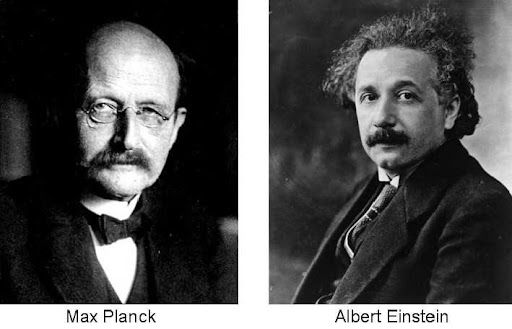The Infinitesimal Enigma
Remember your origins: you were not made to live as brutes, but to follow virtue and knowledge.

The development of modern physics began in 1900, when Max Planck introduced the concept of the "elementary quantum of action" to the world. Planck observed that the distribution of energy among the different frequencies that make up the continuous spectrum of thermal electromagnetic radiation emitted by a black body could not be based on the idea of an infinitely divisible continuum. In short, he said that energy cannot be emitted or absorbed by matter in the form of radiation in any small amount at will, but that this amount of energy is bound to a precise measure. Specifically, Plank said that the ratio of the energy (E) of a monochromatic wave to its frequency (v) is always a multiple of a universal constant (h). Planck's constant (h) has the "dimensions" of an action. In physics, action is energy multiplied by time. Quantization (quantum) is the physical concept that expresses this action of emission and absorption. Planck defined it as a "property of material systems". But then came Einstein, who said in 1905 that quantum was not only a property of material systems, but also of radiation. Until then, radiation had only been identified as a wave, but Einstein attributed a particle aspect to it: the photon.
Photons are the quanta or discrete packets of electromagnetic radiation across the entire electromagnetic spectrum, including radio waves, microwaves, infrared, visible light, ultraviolet, X-rays and gamma rays. (here)

Baffling, strange, bizarre. Disturbing.
Then everything happened. The big change came. Everything, everything changed, somehow. Planck and Einstein's concepts were disorienting and seductive. Quantum mechanics was immediately felt as baffling, strange, bizarre. Disturbing. The young physicists (in those days you were young until you were 30 or so) took up the challenge with great excitement, because the quantum seemed to be the way they needed to break away from classical physics and find new paths to explain the infinitely minuscule reality, everything that cannot be seen and yet allows planets to exist. And, of course, human beings. “The cosmos is within us. We are made of star-stuff. We are a way for the universe to know itself”, Carl Sagan wrote, and what connects us to the stars and the wandering matter of the cosmos are precisely the quanta. Or maybe not. Who knows.
Glorious red
Anyway, quantum mechanics (physics in general) is not difficult or foreign. It’s us. Physics is instinctive and elementary science. We use physical concepts whenever we look around and wonder why things happen. Even kids can. All right, even I don’t really think about how the spectrum of light breaks down to give me those frequencies of glorious red when I’m watching a sunset with my wife beside me. I think about her eyes turning crimson. Her excitement, shaking my hand. But the sunset is physical, and so are my wife and I. This is not a reduction of people and phenomena to something purely mechanical, but a connection of things. The two of us, the sunset, the infinitely minuscule and the infinitely vast.

Remember your origins
All this inspires me.
I don’t know why I study this matter all the time and why I have the need to write it down and share it with somebody. “Michael, why are you talking about this stuff?” you may ask. Well, I don’t have a clue. It is like a memory resonating somewhere. It is like a code of cosmic belonging. In his Divine Comedy, Dante Alighieri wrote: “Remember your origins: you were not made to live as brutes, but to follow virtue and knowledge.” Perhaps that is the point.
The greatest enigma
But let’s stop for a moment to think about this: Classical mechanics tells you exactly how the position of a stone you throw changes over time. It was Newton who gave us the exact, inviolable rules to define how everything in the universe moves in response to everything else. Bonds and correlations. Classical mechanics is simple, beautiful, and compelling. It is transparent and reassuring. Quantum mechanics, on the other hand, offers nothing reassuring; in fact, it takes away all certainty. It offers not rules, but enigmas. And the enigma at the heart of everything we see when we look at the world. This is what throbs at the heart of quantum mechanics, and what stirred the restless souls of those early young 20th-century physicists who embraced Plank’s definition of quantum. What made Einstein himself uneasy. At the heart of quantum mechanics is one of the greatest enigmas in physics of all time: What we see when we look at the world in macroreality looks fundamentally different from what it really is in its microreality.
Why is that?
More Insights
- Introduction to Quantum Mechanics by David J. Griffiths
- In Search of Schrödinger's Cat: Quantum Physics and Reality by John Gribbin
- What Is Real?: The Unfinished Quest for the Meaning of Quantum Physics by Adam Becker
- Quantum: Einstein, Bohr and the Great Debate About the Nature of Reality by Manjit Kumar
- Course of Theoretical Physics: Vol. 3, Quantum Mechanics: Non-Relativistic Theory by L.D. Landau
- Advanced Quantum Mechanics by J.J. Sakurai
- The Hidden Domain: Home of the Quantum Wave Function, Nature's Creative Source by Norman Friedman
- Life on the Edge: The Coming of Age of Quantum Biology by Johnjoe McFadden
